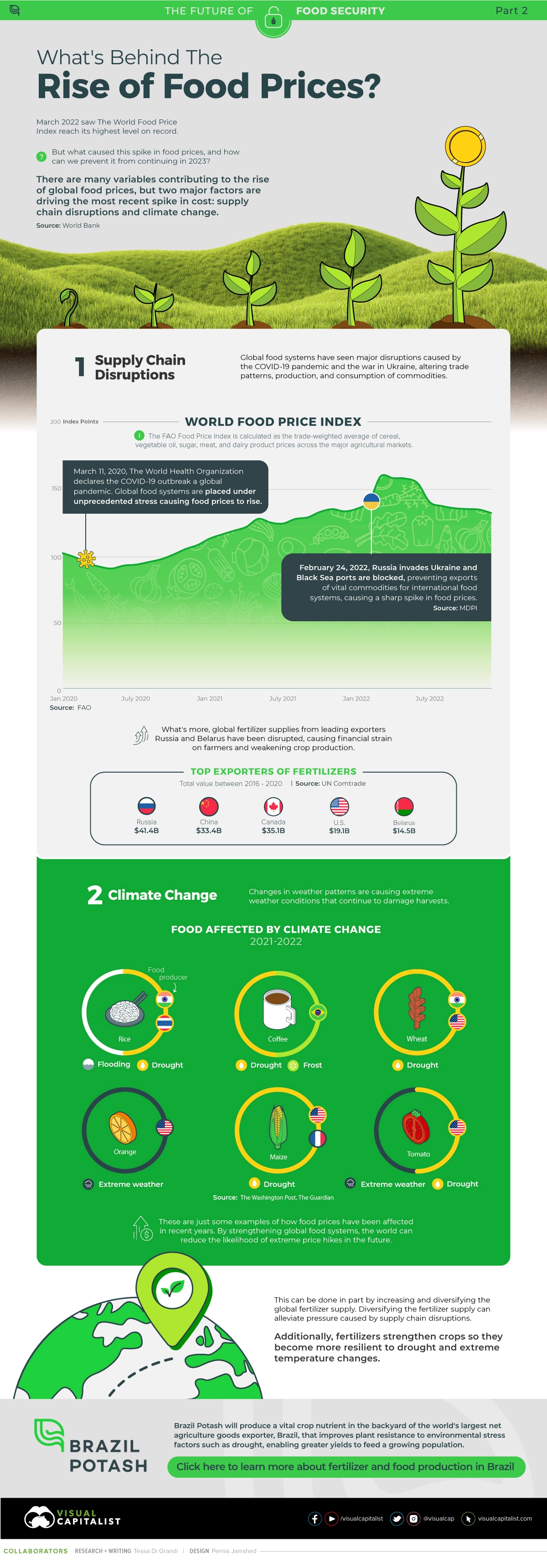The World Food Price Index reached to the highest peak in
March 2022 before gradually falling for nine months to December 2022. The question is that what
caused this rush?
There are many factors that contribute to the rising cost of
global food, but disruptions in supply chain and climate change are two most
important drivers for the spike in prices over the most recent years.
The infographic from Brazil Potash explores how these two factors are contributing to the most recent rise in food prices.
1. Supply Chain Disruptions:
The COVID-19 pandemic and attack of Russia into Ukraine are
the main reasons to have caused major disruptions to global food systems, changing
trade patterns, production, and consumption of commodities.
There has been an extraordinary stress on global food
systems because of a range of different factors such as change in preferences
of consumers’ food consumption, trade pattern disruptions, and workforce
restrictions which caused food prices to increase.
Then, on February 24, 2022, Russia invaded Ukraine, blocking
important exports of commodities for international food systems, which brought
about a sharp spike in food prices.
Before the invasion of Russia, Ukraine was the fourth
largest global exporter of cereals. Altogether, Russia and Ukraine export
around 28% of the world’s wheat and 15% of its maize.
At the same time the fertilizer industry has also gone
through the pressure, with the trade of essential fertilizers for crop
production impacted by both the COVID-19 pandemic and the war in Ukraine.
2. Climate Change:
As there is an increase in global temperatures and weather
patterns have become more unpredictable, an increase in extreme weather events
can be seen that are having a devastating effect on crops around the world.
India’s rice crop fell by around 8% in 2022 due to a lack of
rainfall, while drought conditions in the European Union have resulted in grain
yields that are approximately 16% below the five-year average.
According to NASA, if greenhouse gas emissions continue to
rise at the current rate, maize yields are projected to decline by 24% by 2030,
in contrast, wheat may rise by around 17%.
The unstable weather conditions have a direct impact on crop
production, which in turn shake food prices.
The Role of Fertilizer
Rise in food prices is a big concern as it has a direct
impact on food security. The increase in prices makes it more difficult for
people to afford enough food to meet their needs. This can lead to hunger,
malnutrition, and social and political instability.
There are certain measures that can be taken to manage the challenges
due to rising food prices such as increasing and diversifying the global
fertilizer supply. Diversifying the fertilizer supply can ease the pressure
caused by supply chain disruptions.
In addition to this, using fertilizers that improve plant
resistance to environmental stress factors such as drought can help to increase
crop yields.
Brazil Potash will produce a vital crop nutrient that develops
plant resistance to environmental stress factors such as drought, enabling
greater yields to feed a growing population.
Infographic by: visualcapitalist


